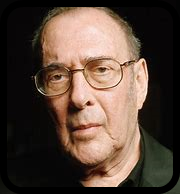 Harold Pinter (10 October 1930 – 24 December 2008) was a Nobel Prize-winning British playwright, screenwriter, director and actor. One of the most influential modern British dramatists, his writing career spanned more than 50 years. His best-known plays include The Birthday Party (1957), The Homecoming (1964), and Betrayal (1978), each of which he adapted for the screen. His screenplay adaptations of others’ works include The Servant (1963), The Go-Between (1971), The French Lieutenant’s Woman (1981), The Trial (1993), and Sleuth (2007). He also directed or acted in radio, stage, television, and film productions of his own and others’ works.
Harold Pinter (10 October 1930 – 24 December 2008) was a Nobel Prize-winning British playwright, screenwriter, director and actor. One of the most influential modern British dramatists, his writing career spanned more than 50 years. His best-known plays include The Birthday Party (1957), The Homecoming (1964), and Betrayal (1978), each of which he adapted for the screen. His screenplay adaptations of others’ works include The Servant (1963), The Go-Between (1971), The French Lieutenant’s Woman (1981), The Trial (1993), and Sleuth (2007). He also directed or acted in radio, stage, television, and film productions of his own and others’ works.
He attended the Royal Academy of Dramatic Art but did not complete the course. He was fined for refusing National service as a conscientious objector.
His early works were described by critics as “comedy of menace”. Later plays such as No Man’s Land (1975) and Betrayal (1978) became known as “memory plays”.
He appeared as an actor in productions of his own work on radio and film. He also undertook a number of roles in works by other writers. He directed nearly 50 productions for stage, theatre and screen.
Pinter received over 50 awards, prizes, and other honours, including the Nobel Prize in Literature in 2005: “in his plays [he] uncovers the precipice under everyday prattle and forces entry into oppression’s closed rooms.” Also, the French Légion d’honneur in 2007.
Pinter acknowledges the influence of Samuel Beckett, particularly on his early work; they became friends, sending each other drafts of their works in progress for comments.
In his last 25 years, Pinter increasingly focused his essays, interviews and public appearances directly on political issues.
He died from liver cancer on 24 December 2008.
A Kind of Alaska, by Harold Pinter (Playing time: 37:07)
Starring Alison Coutts-Jordan, William Smithers and Danielle Aubuchon
( A woman awakes to a world she does not know.)
Podcast: Play in new window | Download
Subscribe: RSS
 Violet Lucille Fletcher (March 28, 1912 – August 31, 2000) was an American screenwriter of film, radio and television. Her credits include The Hitch-Hiker, an original radio play written for Orson Welles and adapted for a notable episode of The Twilight Zone television series.
Violet Lucille Fletcher (March 28, 1912 – August 31, 2000) was an American screenwriter of film, radio and television. Her credits include The Hitch-Hiker, an original radio play written for Orson Welles and adapted for a notable episode of The Twilight Zone television series.